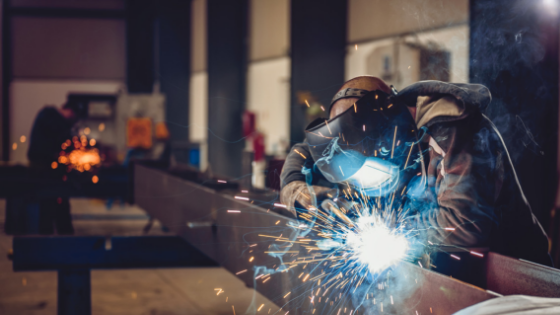Also referred to as “hot work” jobs, OSHA regulation 29 CFR 1910.252 requires employees to be properly protected from hazards associated with welding, cutting, and brazing. Any job environment that uses welding or cutting equipment should follow the requirements outlined below, regardless of industry type.
Employers should be aware of the unique combinations of risks that can affect both the safety and the health of workers under these conditions, including but not limited to fire, explosions, electric shock, radiation, toxic atmospheres, and burns. These risks are not to be taken lightly. More than four deaths per one thousand workers occur from welding, cutting, and brazing jobs, and maintaining proper compliance at all times can help to reduce that number.
Key Requirements
Before you should allow any welding or cutting activity to occur, you should first inspect the work area to ensure it allows for safe welding and cutting. Outline and document all precautions in the form of a written permit. Consider the following fire prevention and protection and personnel protection when you assess each work area.
Fire Prevention and Protection
Following basic fire prevention and protection procedures, employers should eliminate fire hazards within the vicinity, provided the object being cut or welded cannot be readily moved. If you can’t relocate fire hazards, and the welded or cut item can’t be moved, you should take care to install guards that will shield surrounding objects from sparks, heat, and slag. If neither of the above options are possible within the welding or cutting area, then you should not weld or cut in that area. Workers should not be allowed to weld or cut in any of the following situations:
- Areas where management has not approved cutting or welding
- Buildings with sprinkler systems that prevent cutting or welding
- Areas with explosive atmospheres due to flammable gases, dust, vapors or liquids in the air
- In areas close to large amounts exposed, readily ignitable materials like paper bales, cotton, or bulk sulfur
You may need to take extra precautions when working with or near combustible material, such as those that might be on the floor below the working area. Sparks that fall through cracks in the floor could impact the combustible material below. You should take increased precautions regarding open doorways, windows, or cracks or holes in the wall. In any event, working and accessible fire extinguishing equipment are a must. Depending on the work you are performing, you may choose to use buckets of water or sand, portable fire extinguishers, or water hoses. If you are performing work that could ignite more than a minor fire, you must have a fire watcher on duty at all times. Fire watchers are also required when you are working with or near combustible material (see 1910.252(a)(2)(iii)(A)(1-4) for more details).
As a general rule, employers and supervisors should take care to keep staff well informed of the regulations surrounding hot work, as well as the potentially life threatening consequences of deviating from the regulations. Workers may not always be aware of nearby combustibles, explosive atmospheres, or other nearby hazards. Supervisors are also required to ensure fire watchers are available at all times during any welding or cutting activity.
Benefiting from these tips so far?
Download our Work Permits eBook for more best practices!
Protection of Personnel
The safety of every worker should come first in any welding, cutting or brazing job, including not only those directly performing the work, but anyone else who may somehow be affected by welding or cutting activities. To ensure utmost safety for welders and cutters, you should enforce the following protective measures.
- Eye protection, such as goggles and face shields for both welders and attendants should be worn
- Helmets and hand shields should be worn at all times during arc welding or arc cutting activity
- Ensure scaffolds, runways and platforms are equipped with railing to prevent falls
- Welding cable and equipment should not obstruct ladders or passageways
- Protective clothing that best fits the nature of the work involved should be worn
- After welding activities are complete, the hot metals should be clearly marked with a sign to warn other workers
Additional Precautions
Suffice it to say that welding, cutting and brazing activities can be extremely hazardous. There exist as many possibilities of hazards and the necessary precautions needed as there are specific welding and cutting scenarios, which means the contents of this chapter should not be considered comprehensive by any means.
For specific information regarding the information covered in this chapter, or for additional insights into the regulation regarding welding, cutting and brazing, you can view the full regulation here.
